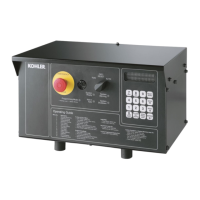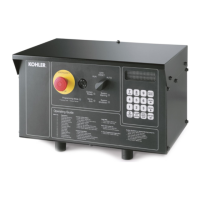TP-6356 4/12 Appendix 221
Appendix F Electrical Noise and Wiring Practices
Adapted from Service Bulletin SB-640 4/04.
Electrical noise is an unwanted electrical signal that can
cause errors in measurement, loss of control,
malfunctions in microprocessor-based control systems,
errors in data transfer between systems over
communication links, or reductions in system
performance.
Good system design and wiring practices can minimize
noise levels and the effects of noise.
Noise, because of its random nature, is typically
characterized by frequency distribution. Many noise
sources are broad-spectrum, that is, they produce many
frequencies distributed over a wide range. Broad-
spectrum noise is particularly troublesome because it
cannot be removed easily by filtering and because it can
affect a variety of systems in unpredictable ways. One
common source of broad-spectrum noise is a switch,
which can produce voltage and current changes when
an electrical circuit is connected and disconnected.
Coupling is the transfer of signals between separate
circuits. Signals from one circuit become noise in
another. The amount of coupling is cumulative and is a
function of the proximity of the circuits, their orientation,
exposed area, and length of run. Minimize coupling by
the following:
D Isolating circuits from each other by using separate
raceways or conduit for AC and DC circuits
D Separating circuits from each other by locating them
as far apart as possible
D Enclosing circuits with a grounded metallic shield
such as an enclosure, metallic conduit, or cable shield
D Running conductors perpendicular, rather than
parallel, to each other
D Running wires loosely and randomly rather than
bundling them tightly together
D Twisting a circuit’s wires together in pairs
In an industrial environment, there are typically five
types of circuits with different noise emission and
rejection capabilities. The five types of circuits are as
follows:
D High-Power Distribution. Circuits to high-power
loads such as large electric motors and heaters can
emit transient high levels of broad-spectrum noise.
Loads on high-power distribution circuits are nearly
immune to noise.
D General Purpose Power Distribution. Circuits to
medium-power loads such as lighting, offices, light-
duty equipment, and small motors such as fans and
pumps can emit transient, medium levels of broad-
spectrum noise. Some electronic equipment, such as
computers, emits constant levels of broad-spectrum
noise in addition to transient broad-spectrum noise.
Loads on general-purpose circuits, except for
sensitive electronic equipment, are nearly immune to
noise.
D Control. Control circuits include DC circuits and
120 VAC maximum AC circuits that operate at a low
power level (less than 1 W). Typical circuits include
circuits to switches, actuators, and dry-contact relays,
including the generator engine-start circuit. Control
circuits emit transient low levels of broad-spectrum
noise and are fairly immune to noise.
D Analog. Analog circuits are low-voltage DC circuits
that convey measurement information as relatively
small changes in current or voltage. Typical circuits
include those connected to the controller’s analog
inputs. Analog circuits create the lowest noise levels
and are the most sensitive to noise.
D Communication and Signaling. Communication
and signaling circuits are low-voltage circuits that
convey information. Typical circuits include RS-232
and RS-485 serial communication lines, telephone
lines, and computer network lines. These circuits
create noise with frequencies related to the
communication signaling rate. These circuits have
some level of built-in noise immunity. Typical systems
will detect or correct errors caused by noise below
certain levels, but with a corresponding reduction in
the data transfer rate.
When planning an installation, separate all of these
types of circuits as much as possible to minimize the
hazards of insulation failure, accidental miswiring, and
noise coupling. For best results, install control circuits,
analog circuits, and communication and signaling
circuits separately. Combining circuit types is
unavoidable in the controller’s enclosure and some
other areas.
Note: It is very important to isolate high- and medium-
power circuits in raceways or conduit separate
from the other types of circuits.

